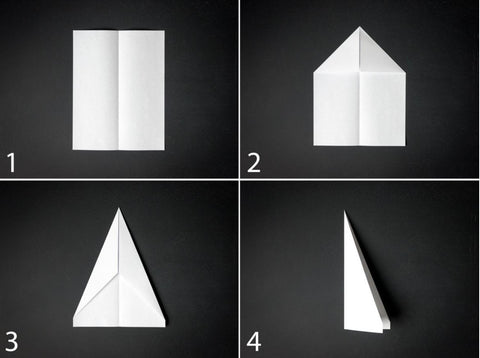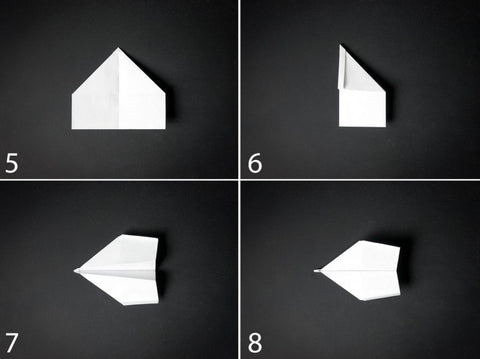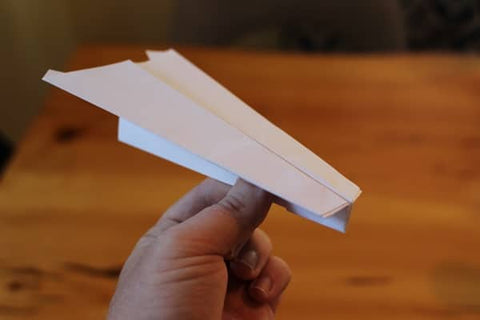PLANES
BUNDLES
ACCESSORIES
EDUCATORS
How to make a paper airplane | POWERUP for kids

Building paper airplanes is one of those rare activities that is both genuinely fun and actually educational. Kids love making things—especially things that can fly. Whether they know it or not, by building paper airplanes, kids are learning valuable lessons about how things work and, even more importantly, about the joy that comes with building.
Here are some helpful tips from POWERUP Toys for parents and educators about paper airplane building and how to make doing so fun, un-stressful, and valuable to everyone involved.
Steps to Make a Simple Paper Airplane
You don't need much to make a paper airplane. Just a sheet of letter-sized paper, a ruler or straight edge, and something to use as a weight (paper clip or penny).
First things first, though, is for parents and teachers to keep in mind just how significant something as seemingly insignificant as building a paper airplane can be in the life of a young person. For some, paper airplane building will be their first foray into the world of science, engineering, or physics. If that first experience is stressful or tense in any way, kids may sense that and can associate that tension with learning topics that should be considered fun, engaging, and easy.
So, after parents and educators have put themselves in the right calm, playful mindset, the following steps will make things easy:
1) Fold a piece of paper in half lengthwise.
2) Fold the upper cockpit, so the paper looks like a house
3) Fold the cockpit down
4) Fold the lower cockpit

5) Make the first set of wingfolds
6) Make the second set of wingfolds
7) Gently the paper airplane up
8) Solidify all folds, and yup, you're done!

Paper Airplane Folding | More On How to Fold
There are many ways to fold a paper airplane. The steps above are just one method. There are variations on the design, and there are also more complicated versions that can be fun to try once you have mastered the basic design.
To make things even more interesting, try folding your paper airplanes out of different types of paper. How does weight affect flight? How about texture? Does it make a difference if the paper is glossy or matte? You can also decorate your planes with markers or stickers before you fly them.
Flying | How to Get Your Paper Airplane Off the Ground
Now that you've built your plane, it's time to fly it! For indoor flying, find a large open space like a gymnasium or school cafeteria. Outdoors, a park or backyard will do nicely.
To get your plane off the ground, you'll need to give it a good throw. Start by holding the plane at the very end of the tail. Then, swing your arm back and release the plane when your arm is pointing straight out in front of you.
If your paper airplane doesn't fly very well, don't worry. There are lots of factors that can affect flight, from the type of paper you use to how well the folds are executed. With a little practice, you'll be an expert in no time!
More Paper Airplane Tips for Parents and Educators
Here are a few additional tips to keep in mind when building and flying paper airplanes:
-
Paper airplanes are more than just a fun activity. They can also be used to teach kids about science, math, and engineering.
-
Be sure to supervise children when they are building and flying paper airplanes.
-
If you're flying indoors, be mindful of obstacles like ceiling fans and light fixtures.
-
Have fun and be creative! There are no wrong ways to build a paper airplane.
Other Types of Simple Paper Airplanes for Kids
Once you've mastered the basic design, there are lots of other types of paper airplanes you can try. Check out these designs for some paper airplane inspiration.
Bulldog Dart Paper Airplane

The Boomerang Paper Airplane

More impressive paper airplane designs...
Why does a paper airplane fly? Fun Science Info for Kids
How do paper airplanes fly? It's all thanks to four things: lift, drag, thrust, and, of course, gravity.
Lift is the force that keeps an airplane in the air, drag is the force that slows it down, and thrust is the force that you use to throw a paper airplane forward.
Lift is created by the airplane's wings. As air passes over the wings, they create a low-pressure area above the wing and a high-pressure area below. This difference in pressure creates lift, which lifts the plane into the air.
Drag is created by anything that slows down the airflow around the plane. The more streamlined a plane is, the less drag it will have. That's why most paper airplanes have long, narrow tails—to help them fly more smoothly through the air.
Thrust is the force you get when you push a paper airplane forward.
Gravity plays a role in that when paper airplanes are thrown up, gravity pulls them down. This causes a difference of air pressure on the airplane wings, which then causes lift.

Now that you know how paper airplanes fly, why not build your own and see how far it can go?
How to Make a Paper Airplane Fly Further
Yes, if you're kid or students are asking about how to make their paper airplanes fly further, there are plenty of things you can encourage them to do. For instance:
- Use lighter paper. Heavier paper will weigh the plane down and make it harder to fly.
- Fold the wings neatly and evenly. Uneven folds can affect the plane's balance and make it harder to fly straight.
- Make sure the tail is pointing in the right direction. The tail helps stabilize the plane, so if it's pointing in the wrong direction, the plane may not fly as well.
- Decorate your plane with streamers or stickers. This will add some extra weight, but it can also help the plane fly further by acting as a stabilizer.
- Try different types of paper to see what works best. Some types of paper, like construction paper, are heavier and may not fly as well. Others, like tissue paper, are very light and can help the plane fly further.
You’re ready for takeoff ~ enjoy!
---
If your kid or student is interested in learning about some of history's coolest aviators and coolest planes check out these kid-friendly resources:
Recent Articles
- Soar High with Mom: Why POWERUP Is the Perfect Mother's Day Activity
- POWERUP WINTER CONTEST: Most Creative Design
- Easter Joy with POWERUP 4.0: The Ultimate Gift for the Season
- Fun facts about airplanes | POWERUP for kids
- The world's fastest planes | POWERUP for kids
- Famous astronauts | POWERUP for kids
- Cool spaceships | POWERUP for kids
- History's coolest planes | POWERUP for kids
- History’s coolest aviators | POWERUP for kids
- Fun answers to your kid's flying questions | POWERUP for kids

















